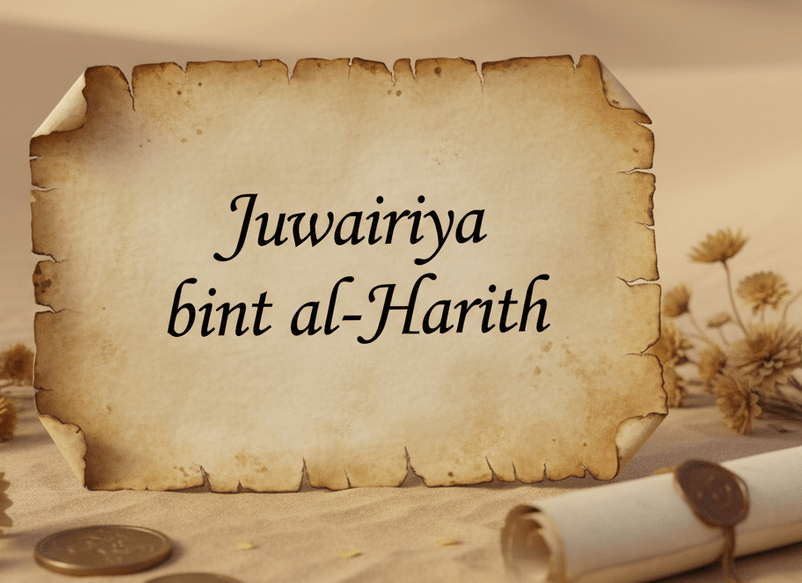Juwairiya bint al-Harith was a notable and revered figure in early Islamic history, best known as the eighth wife of the Prophet Muhammad and as a Mother of the Believers. She hailed from the prominent Banu Mustaliq clan, being the daughter of its chief, Al-Harith ibn Abi Dirar. Her life story is deeply intertwined with significant events during the formative years of the Islamic community. Here is a comprehensive content about her, including her background, marriage, character, and legacy.
Juwairiya bint al-Harith

juwairiya bint al-Harith was born around 608 CE into the noble Banu Mustaliq tribe, a sub-clan of the larger Khuza’a tribe renowned in the Arabian Peninsula. Her father was the leader of the tribe, which held considerable influence and was known for its strength. Before her marriage to the Prophet Muhammad, her given name was Barra, which the Prophet later changed to Juwayriya—meaning “young woman” or “little girl”—a name reflecting her new identity in the Muslim community.
Her tribe’s fortunes changed dramatically following a conflict with the Muslims. The Banu Mustaliq were involved in hostilities presumed to be initiated over mutual suspicions before engaging in a fight near a well called Al-Muraysi. The Muslims decisively won after a short battle, taking many from the tribe as captives, including Juwayriya. The aftermath included the confiscation of goods and livestock and the enslavement of many, including Juwayriya herself.
Captivity and Marriage to the Prophet Muhammad
Captured as a war captive, Juwayriya’s initial fate was difficult, and she was put into bondage under a companion of the Prophet. She sought to gain her freedom through a contractual agreement (mukataba), negotiating with her owner to buy her emancipation. When she approached the Prophet seeking help, he not only facilitated her freedom but also proposed marriage to her—a proposal she accepted.
The marriage of Juwayriya to the Prophet Muhammad had a significant social impact. Moved by their union, many Muslims freed captives of the Banu Mustaliq tribe, seeing them as related to the Prophet and treating them with respect and kindness. This act fostered reconciliation and harmony between the Muslims and the previously hostile tribe. The dowry was notable, with the Prophet freeing about forty slaves belonging to her tribe.
Read more: Zaynab bint Jahsh
Personality and Piety
Juwairiya was known for her devoutness and exemplary character. She was described as beautiful, polite, kind-hearted, and devoted to worship and remembrance of God. An authentic hadith describes how she engaged continuously in dhikr (remembrance of Allah) from after the dawn prayer until mid-morning, reflecting her spiritual dedication.
Her conduct after marriage to the Prophet exemplified humility and commitment. She fully embraced her role not only as the wife of the Prophet but as a mother of the believers, influencing the early Muslim women by her noble example and faith.
Read about: Zaynab bint Khuzaymah
Legacy and Death
Juwayriya lived many years after the Prophet’s passing, continuing to be respected by the Muslim community. She passed away around the year 676 CE (50 AH) and was buried in the famous Al-Baqi Cemetery in Medina, a burial ground reserved for many of the Prophet’s family members and companions. Her life remains a testament to faith, resilience, and reconciliation in early Islam.
Recommend: mothers of believers in islam
FAQs
Who was Juwayriya bint al-Harith?
Juwayriya bint al-Harith was the daughter of the chief of the Banu Mustaliq tribe and later became the eighth wife of the Prophet Muhammad, honored as a Mother of the Believers.
How did Juwayriya become a wife of the Prophet Muhammad?
She was captured during the battle against Banu Mustaliq, became a captive, sought freedom through a contract, and the Prophet Muhammad helped her gain emancipation and married her.
What was the social impact of Juwayriya's marriage to the Prophet?
Following their marriage, many Muslims freed captives of her tribe, leading to reconciliation and improved relations between Muslims and Banu Mustaliq.
What is known about Juwayriya's character and spirituality?
She was known for her beauty, humility, and strong devotion to worship and remembrance of Allah, spending long hours in dhikr.
Where is Juwayriya bint al-Harith buried?
She was buried in Al-Baqi cemetery in Medina after her death around 676 CE (50 AH).
Conclusion
Juwayriya bint al-Harith’s life journey—from nobility to captivity, then to becoming a beloved wife of the Prophet Muhammad—illustrates a powerful story of liberation, faith, and social healing. Her marriage to the Prophet not only freed her but also led to the emancipation of many from her tribe, symbolizing mercy and unity. Her spiritual dedication and pious lifestyle continue to inspire Muslims worldwide as an example of strength, humility, and devotion. Juwayriya’s legacy is not only historical but also spiritual, marking her as a significant figure in Islamic history and a guiding role model for generations.

